The AMD Radeon R9 290 Review
by Ryan Smith on November 5, 2013 12:01 AM EST- Posted in
- GPUs
- AMD
- Radeon
- Hawaii
- Radeon 200
Overclocking
Finally, let’s spend a bit of time looking at the overclocking prospects for the 290. Without any voltage adjustment capabilities and with AMD binning chips for clockspeeds and power consumption we’re not necessarily expecting a lot of headroom here, but none the less it’s worth checking out to see how much more we can squeeze out of the card.
Even though we’re officially limited to AMD’s Overdrive utility for the moment for overclocking, Overdrive offers a wide enough range of values that we shouldn’t have any problem maxing out the card. In fact we’ll be limited by the card first.
| Radeon R9 290 Overclocking | |||
| Reference Radeon R9 290 | |||
| Shipping Core Clock | 662MHz | ||
| Shipping Boost Clock | 947MHz | ||
| Shipping Memory Clock | 5GHz | ||
| Shipping Boost Voltage | ~1.18v | ||
| Overclock Core Clock | 790MHz | ||
| Overclock Boost Clock | 1075MHz | ||
| Overclock Memory Clock | 5.6GHz | ||
| Overclock Max Boost Voltage | ~1.18v | ||
Despite the lack of voltage control, when it comes to overclocking the 290 we were able to achieve solid overclocks on both the GPU and the memory. On a boost clock basis we were able to push the 290 from 947MHz to 1075MHz, an increase of 128MHz (14%). Meanwhile we were able to push the memory from 5GHz to 5.6GHz before artifacting set in, representing a 600MHz (12%) memory overclock. Being able to increase both clockspeeds to such a similar degree means that no matter what the video bottleneck is – be it GPU or memory – we should see some kind of performance increase out of overclocking.
On a side note, for overclocking the 290 we stuck with moderate increases to both the maximum fan speed and the PowerTune limit. In the case of the former we used a 65% maximum fan speed (which actually proved to be more than what’s necessary), while for the latter we went with a 20% increase in the PowerTune limit, as at this point in time we don’t have a good idea for what the safe power limits are for the reference 290/290X board. Though in either case only FurMark could push the overclocked card to its power limit, and nothing could push the card to its fan speed limit. Similarly we didn’t encounter any throttling issues with our overclocked settings, with every game (including CoH2) running at 1075MHz sustained.
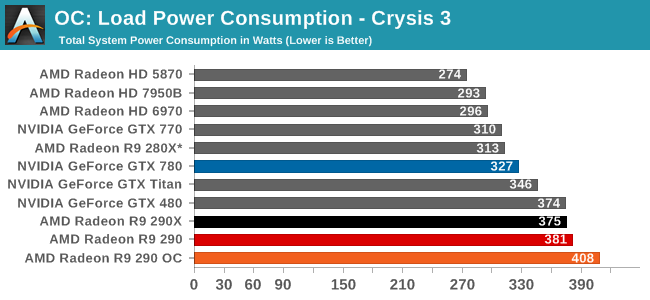
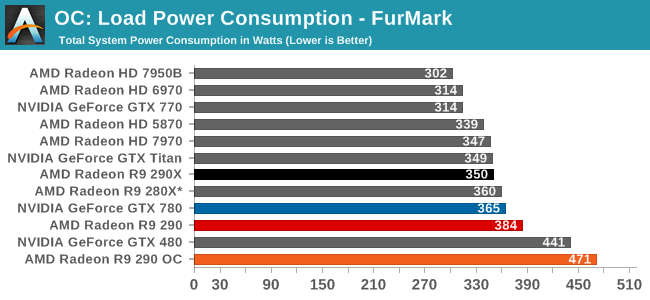
Taking a brief look at power, temp, and noise before jumping into our gaming performance results, we can see that overclocking the card has a measurable impact on power consumption under both Crysis 3 and FurMark. With Crysis 3 we’re clockspeed limited before we’re power limited, leading to an increase in power consumption of 27W, while under FurMark where we were power limited it’s a much more academic increase of 87W.
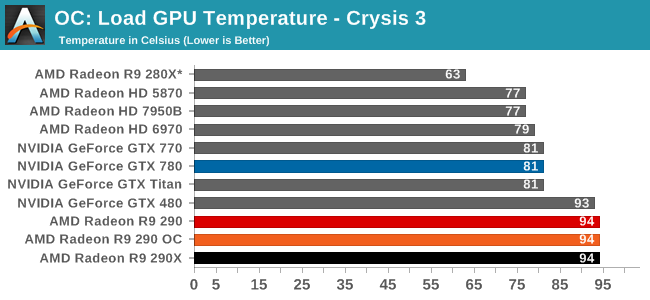
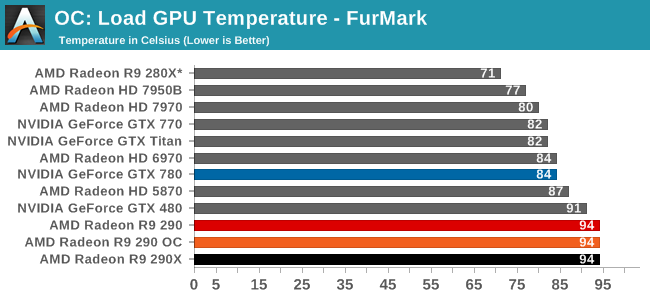
Since the 290 already ships at the highest temperate limit it allows – 95C – our sustained temperatures are unchanged even after overclocking.
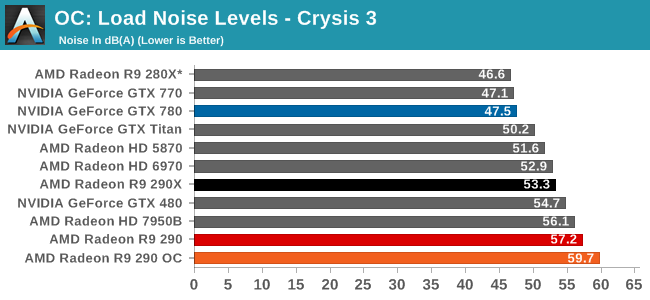
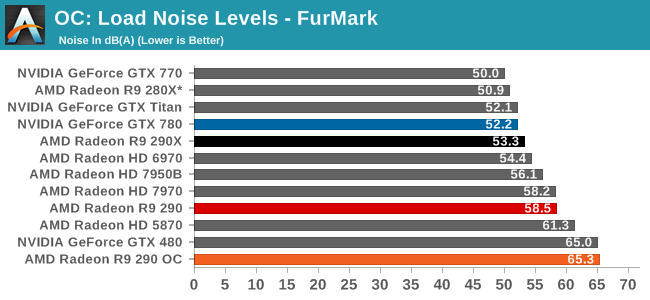
The 290 is already an unreasonably loud card at stock, and unfortunately the fan speed increases needed to handle the greater heat load from overclocking only make this worse. Under Crysis 3 we peaked at 59.7dB, or 49% fan speed. While under FurMark we peaked at 65.3dB, or 59% fan speed. For these noise levels to be bearable the 290 really needs to be fully isolated (e.g. in another room) or put under water, as otherwise 59.7dB sustained is immensely loud for a video card.
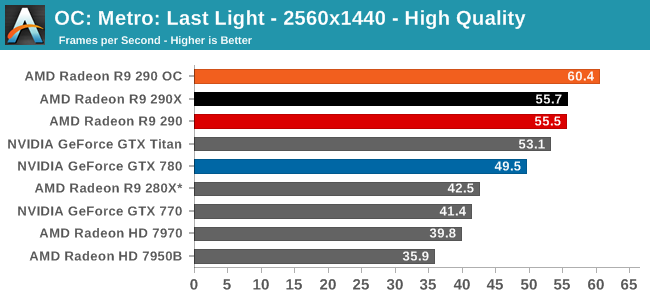
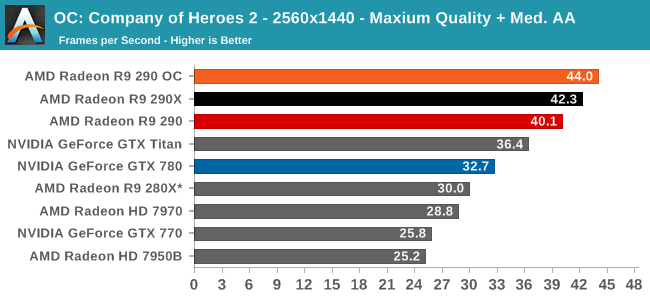
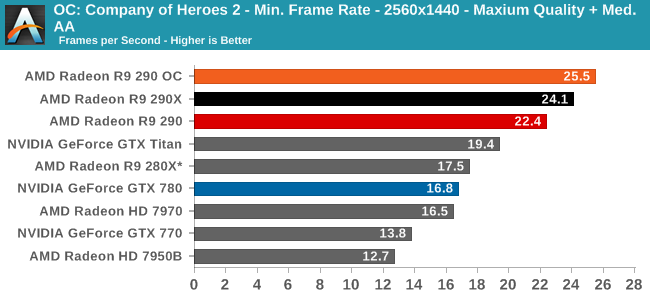
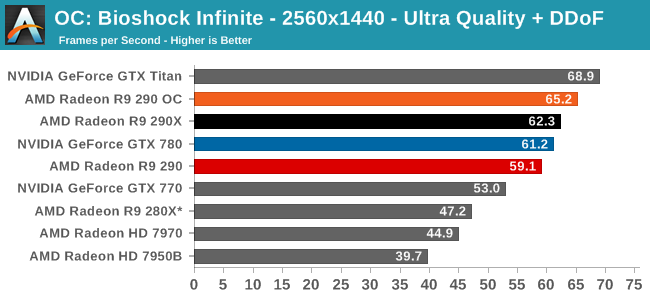
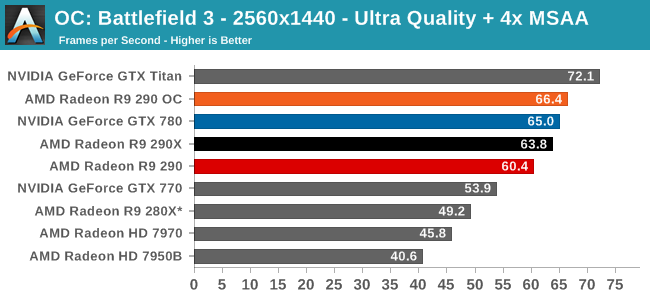
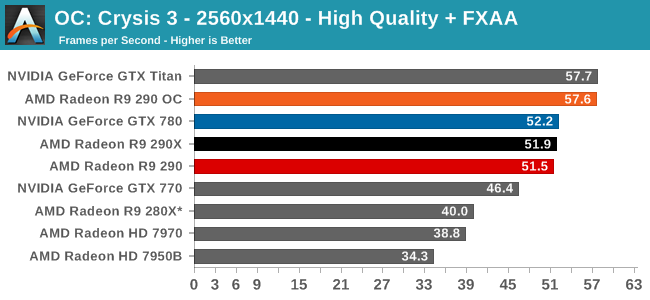
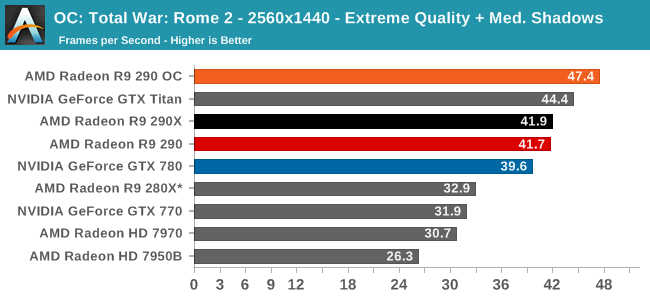
Finally getting to the matter of game performance, we’re seeing consistently strong scaling across every game in our collection. The specific performance increase depends on the game as always, but a 14% core overclock and 12% memory overclock has netted us anywhere between 9% in Metro up to the full 14% in Total War: Rome II. At this performance level the 290 OC exceeds the performance of any other single-GPU card at stock, and comes very close to delivering 60fps in every action game in our benchmark suite.










295 Comments
View All Comments
HisDivineOrder - Tuesday, November 5, 2013 - link
Haha, spoken like someone who's never heard a card this loud. I can't wait to see all these cards on sale on ebay and forums everywhere. "I tried it and it's not for me, sidegrading to a 780," they'll say.This card is so loud you're going to be shocked by it. It's going to blow people's minds and it may even convert a few fanboys.
Finally - Tuesday, November 5, 2013 - link
If he buys one with a nice custom fan, there won't be anything left to complain about. Truly terrible outlook for an Nvidiot, isn't it?TheJian - Tuesday, November 5, 2013 - link
You're forgetting they are using ref NV also. You don't get that when you buy an NV card and they come overclocked on top of quiet. Also this thing will draw the same watts no matter what. It remains to be seen how good a different cooler will actually be. Did AMD really choose two terrible fans for their product launch? Seriously? I'm wondering how much they can really fix this situation. AMD had to know this would cause bad reviews about noise nearly everywhere and even on AMD loving sites. I can't believe they are completely dumb, and chose a total piece of junk for the fan/heatsink here. I really think people are putting to much faith in a fix with a fan change. They are at 95 all day basically, how much fan do you need to fix that?If NV runs their gpus at 95 tomorrow (and cranked up even more to meet the noise they're getting here) these cards will both be spanked. You get a better cooler on NV cards that are NOT ref also.
jnad32 - Tuesday, November 5, 2013 - link
The way I look at it, AMD is looking like an absolute genius. Everyone was ripping them on the 290X for it being too hot and too loud anyway. So instead of keeping the sound levels down they just went for what they do best, price/performance. They are now blowing every other card out of the water. There isn't a card on the planet that can touch this card in price/performance. Yea its loud as hell but, at least you have to think about it now just because of the price. What I really want to see is them unleash the 290X sound threshold and see what kind of raw numbers it can put up. Lets be honest, the only people who should buy reference cards are the ones who are putting water blocks on them.People have been saying this about the temp since launch, and I still don't get it. If AMD designed the chip to run at those temps, what's the big deal as long as it's not damaging it.
swing848 - Tuesday, November 5, 2013 - link
It will only get loud for me when playing games or the occasional benchmark. During games I wear headphones, and during benchmarks I can leave the room. I have a room dedicated to computer use and the house has good sound proofing, so, it will not bother other people.If I want it quiet I will use a water cooler with a large radiator and fan.
It is better than dumping all the hot air from the video card into my case, even if it is well cooled with 200mm fans. I overclock my CPU and I do not want it, RAM, or chips on the motherboard to get any hotter than necessary.
zeock9 - Tuesday, November 5, 2013 - link
The burning question on my mind at this point is why AMD is restricting board partners from releasing their own custom designed and obviously better performing coolers on this otherwise fantastic card?techkitsune - Tuesday, November 5, 2013 - link
They likely don't want to look bad.It's okay. It's tough doing thermal management. I cram 1,000w of LED into a 30mm x 30mm space. AMD doesn't have the cooling problems that I have. Nor does nVidia nor intel. They should be grateful. :D
HisDivineOrder - Tuesday, November 5, 2013 - link
They don't have them yet. That's why they haven't made custom boards. They're just getting them right now. They're going with what they have, which right now are just the reference boards. In a month or so, they'll have QA'ed some solutions with pre-existing cooling options, assuming said cooling options are good enough to benefit these cards.The thing is, you have to know these cards are running REALLY, REALLY hot to hit these levels at 95 degrees, so... custom coolers may have a hard time handling these cards without some tweaks. Perhaps to get faster fans on there.
Also, it takes time to redesign a board to add VRM's and the 290 and 290X are still very, very new. You're not going to get an MSI Lightning version overnight.
It's a solid deal in price, but man it's a shame AMD didn't offer a better custom cooler more attuned to the very special needs of the 290 series. It's also a shame their board is being pushed so hard and so much above what it seems capable of doing with reasonable power levels.
This is like the Bulldozer of GPU's.
techkitsune - Tuesday, November 5, 2013 - link
AMD could have just spent a few more dollars and used copper instead of aluminum, I would think. They could have easily doubled or tripled thermal conductivity and thus not needed to run the reference cooler anywhere near as high, plus that would leave a LOT of extra overclocking room.I still would buy it for the extra $45 that would have likely entailed, though I do worry about weight at that point. My 9800 GTX+ was pretty hefty, to say the least.
TheinsanegamerN - Tuesday, November 5, 2013 - link
THIS. why does amd, or heck, any manufacturer, insist on using aluminum fins on a 250 watt+ gpu? my old amd 2600xt had a full copper heatsink, and it was nowhere near as power hungry as this card (and it ran cool to boot. never over 47c).use the exact same heatsink, but make those fins copper. wonder how much lower the temps would go?